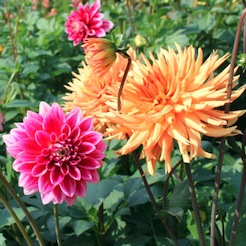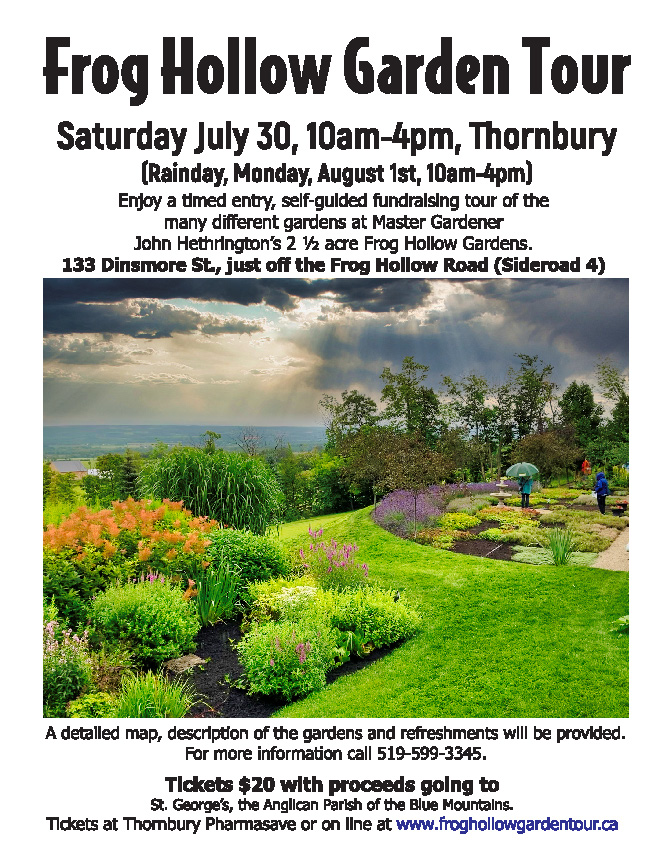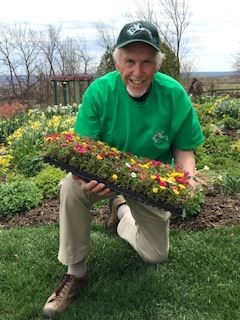 Things to do in your garden this month.
Things to do in your garden this month.
Taken from the Ontario Master Gardener Calendar
by John Hethrington
Past President, Master Gardeners of Ontario.
Please contact John for more information!
 Come to the Frog Hollow Garden Tour of the many different gardens on Saturday, July 30 10am - 4 pm. (Rain Day, Mon Aug 1, 10 am - 4 pm). Proceeds to St. George’s, the Anglican Parish of the Blue Mountains. Click on the poster to the right, for more information!
Come to the Frog Hollow Garden Tour of the many different gardens on Saturday, July 30 10am - 4 pm. (Rain Day, Mon Aug 1, 10 am - 4 pm). Proceeds to St. George’s, the Anglican Parish of the Blue Mountains. Click on the poster to the right, for more information!
Pre-purchase your $20 timed entry tickets on line at www.froghollowgardentour.ca to see our 2½ acre Frog Hollow Gardens. It’s a safe, self-guided tour, with a detailed map and descriptions of the gardens. Refreshments will be served on the deck.
July 2022 Garden Tips:
- Watch for the Japanese beetle on your Asiatic Lilies, Roses, Rose of Sharon, Dahlias, Hollyhocks, and numerous other plants. Handpicking and squeezing, combined with a beetle trap, are the most efficient way to limit these ravaging critters. Luckily, the little red devils don’t eat Day Lilies (Hemerocallis)
- Watch for earwigs and Gypsy moth caterpillars. Spray plants with a 40:1 mixture of water and dish soap.
- Ants are also a problem. The ant powder does not seem to work for me. Maybe the ants didn’t read the instructions to take it back to their nest.
- Trim evergreens, cedar hedges, etc., NOW as needed, not later in the summer.
- Stake straggly annuals and perennials, or pinch them back to promote new growth and make them bushy.
- Raise lawn mower blades for summer mowing. Grass should be at least 5 - 7.5 cm (2 to 3 inches) high to stay healthy and weed free.
- Prune spring flowering shrubs like Forsythia and Spirea after blooming, If you really want to be picky, remove individual spent lilac blooms.
- Water flower beds deeply and try a second round of weeding. Add mulch again to keep the weeds at bay.
- Mulch your tomato plants. When a ripe tomato drops, it won’t split or get muddy. Mulch holds moisture too!
- Thin, hoe, weed and water vegetables as required. (This is why I stick to flowers)
- Water lawns and beds as deeply as you can. WE have had a fairly wet spring, but the hot summer day will dry out your lawn fast.
- Tackle weeds now before they go to seed. Save yourself from weeding their offspring next year.
- Stake tall perennials that may be weakened by too rapid growth.
- Turn compost regularly and check the moisture level - not too wet, not too dry,- like Goldilocks, just right.
A big thank you to everyone who turned out for our Giant Plant Sale at St. George’s, the Anglican Parish for the Blue Mountains, in Clarksburg. You bought over 1,000 donated plants. Thanks to the many plant donors TOO!
John Hethrington, Past President, Master Gardeners of Ontario

 Beaver Valley Probus Club
Beaver Valley Probus Club